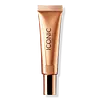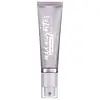What's inside
What's inside
 Key Ingredients
Key Ingredients

 Benefits
Benefits

 Concerns
Concerns

 Ingredients Side-by-side
Ingredients Side-by-side

Water
Skin ConditioningDimethicone
EmollientCetyl PEG/PPG-10/1 Dimethicone
EmulsifyingIsododecane
EmollientTalc
AbrasiveGlycerin
HumectantPhenoxyethanol
PreservativeSodium Chloride
MaskingMagnesium Sulfate
Sodium Dehydroacetate
PreservativeDisteardimonium Hectorite
StabilisingPotassium Sorbate
PreservativePolysilicone-11
Dimethiconol
EmollientBenzoic Acid
MaskingHydrogen Dimethicone
Propylene Carbonate
SolventDehydroacetic Acid
PreservativeAluminum Hydroxide
EmollientEthylhexylglycerin
Skin ConditioningMarrubium Vulgare Extract
Skin ConditioningCitric Acid
BufferingCI 77891
Cosmetic ColorantCI 77492
Cosmetic ColorantCI 77491
Cosmetic ColorantCI 77499
Cosmetic ColorantWater, Dimethicone, Cetyl PEG/PPG-10/1 Dimethicone, Isododecane, Talc, Glycerin, Phenoxyethanol, Sodium Chloride, Magnesium Sulfate, Sodium Dehydroacetate, Disteardimonium Hectorite, Potassium Sorbate, Polysilicone-11, Dimethiconol, Benzoic Acid, Hydrogen Dimethicone, Propylene Carbonate, Dehydroacetic Acid, Aluminum Hydroxide, Ethylhexylglycerin, Marrubium Vulgare Extract, Citric Acid, CI 77891, CI 77492, CI 77491, CI 77499
Water
Skin ConditioningGlycerin
HumectantGlycereth-7 Trimethyl Ether
Skin ConditioningXylitylglucoside
HumectantAmmonium Acryloyldimethyltaurate/Vp Copolymer
Anhydroxylitol
HumectantXylitol
HumectantPhenoxyethanol
PreservativeVp/Va Copolymer
Butylene Glycol
HumectantAgave Tequilana Leaf Extract
AstringentSodium Hyaluronate
HumectantEthylhexylglycerin
Skin ConditioningT-Butyl Alcohol
PerfumingCaprylyl Glycol
EmollientHexylene Glycol
EmulsifyingSodium Hydroxide
BufferingWater, Glycerin, Glycereth-7 Trimethyl Ether, Xylitylglucoside, Ammonium Acryloyldimethyltaurate/Vp Copolymer, Anhydroxylitol, Xylitol, Phenoxyethanol, Vp/Va Copolymer, Butylene Glycol, Agave Tequilana Leaf Extract, Sodium Hyaluronate, Ethylhexylglycerin, T-Butyl Alcohol, Caprylyl Glycol, Hexylene Glycol, Sodium Hydroxide
 Reviews
Reviews

Ingredients Explained
These ingredients are found in both products.
Ingredients higher up in an ingredient list are typically present in a larger amount.
Ethylhexylglycerin (we can't pronounce this either) is commonly used as a preservative and skin softener. It is derived from glyceryl.
You might see Ethylhexylglycerin often paired with other preservatives such as phenoxyethanol. Ethylhexylglycerin has been found to increase the effectiveness of these other preservatives.
Glycerin is already naturally found in your skin. It helps moisturize and protect your skin.
A study from 2016 found glycerin to be more effective as a humectant than AHAs and hyaluronic acid.
As a humectant, it helps the skin stay hydrated by pulling moisture to your skin. The low molecular weight of glycerin allows it to pull moisture into the deeper layers of your skin.
Hydrated skin improves your skin barrier; Your skin barrier helps protect against irritants and bacteria.
Glycerin has also been found to have antimicrobial and antiviral properties. Due to these properties, glycerin is often used in wound and burn treatments.
In cosmetics, glycerin is usually derived from plants such as soybean or palm. However, it can also be sourced from animals, such as tallow or animal fat.
This ingredient is organic, colorless, odorless, and non-toxic.
Glycerin is the name for this ingredient in American English. British English uses Glycerol/Glycerine.
Learn more about GlycerinPhenoxyethanol is a preservative that has germicide, antimicrobial, and aromatic properties. Studies show that phenoxyethanol can prevent microbial growth. By itself, it has a scent that is similar to that of a rose.
It's often used in formulations along with Caprylyl Glycol to preserve the shelf life of products.
Water. It's the most common cosmetic ingredient of all. You'll usually see it at the top of ingredient lists, meaning that it makes up the largest part of the product.
So why is it so popular? Water most often acts as a solvent - this means that it helps dissolve other ingredients into the formulation.
You'll also recognize water as that liquid we all need to stay alive. If you see this, drink a glass of water. Stay hydrated!
Learn more about Water